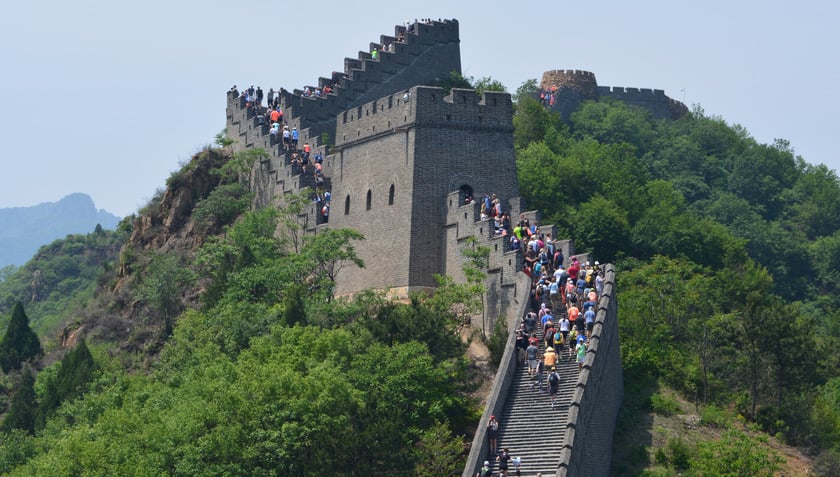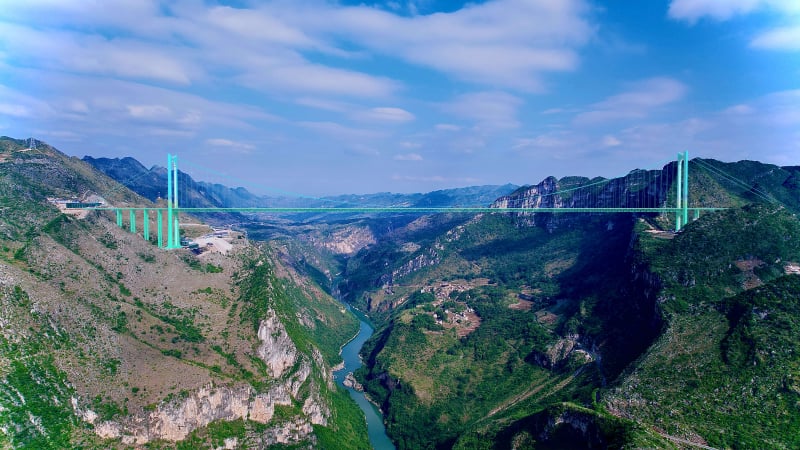The Badaling area, one of the most famous and popular sections of the Great Wall, has seen a remarkable step forward in enhancing the tourist experience since August 2024 thanks to the pioneering use of technology by Chinese food delivery giant Meituan. The company has officially launched its drone delivery service, bringing a completely new approach to serving the needs of tourists right on their journey to explore this world wonder.
Now, visitors to the Great Wall can easily order food, refreshments, or even necessary medical supplies, and receive them quickly through flexible drone flights. With a maximum capacity of 2.3 kg per delivery, the service promises impressive delivery times, which can take as little as 5 minutes from the time of order. It is worth noting that the cost of each drone delivery is only about 4 yuan, a price completely equivalent to Meituan's regular delivery fee, showing the convenience and economy of this technological solution.

The Great Wall is a great symbol and wonder of China, the preservation and development of tourism on the Great Wall is of special concern to this country.
The milestone marks the first drone delivery service to be deployed in the capital Beijing, and is a clear testament to the rapid growth of drone delivery across China, a country that is the world’s largest producer and exporter of civilian drones.

Applying new technologies such as drones and artificial intelligence (AI) is part of those efforts.
However, the application of drones on the Great Wall does not stop at this convenient delivery service. Previously, since 2023, these unmanned aerial vehicles have been put into use in automatic patrol activities, acting as silent "sentinels", contributing to the strict protection of the architectural wonder that has been the pride of the Chinese people for generations.

Since August 2024, in the famous Badaling area of the Great Wall, Chinese food delivery giant Meituan has launched a drone delivery service.
According to Ms. Li Jing, Deputy Director of the Yanqing District Great Wall Management Board, Beijing, a system of 18 automatic drone patrol routes with a total length of more than 20 km has been established in this area. Two drone airports built in the north and south of the Great Wall are capable of carrying out up to 10 patrol flights per day, with each flight lasting from 5 to 10 minutes. The special thing is that after each mission, these drone airports are capable of automatically transmitting the collected image and video data to the management system, helping managers to monitor the conservation status of the relics in a visual and effective way.

With this service, visitors can receive food, drinks or medical supplies in the fastest time of just 5 minutes and the delivery fee is only 4 Yuan.
“In order to further improve the effectiveness of Great Wall protection, we have proactively expanded the application of drone technology to the monitoring and protection of relics. Currently, we are piloting the construction and operation of two drone airports in the Badaling area. Through patrol flights, we can observe the protection status of relics from many different angles, which is difficult to achieve with traditional patrol methods. This has greatly enhanced the effectiveness of Great Wall protection, while overcoming the limitations of long patrol times, long travel distances, and limited human observation range,” Ms. Li Jing emphasized.

The emergence of AI technology and drones greatly supports tourism development here.
In addition to the initial successes, Ms. Li Jing also revealed plans to expand the application of drones in the future. It is expected that by 2025, the application scenarios of drones will continue to be diversified. With the addition of 3 drone airports, the patrol range of drones will be able to cover the entire Badaling area, forming a comprehensive and tight surveillance network.

To improve the effectiveness of protecting the Great Wall, the management board here has expanded the scope of drone application in protecting the relic.
Not only drones, a completely new climbing support service called GoGo has also been deployed at the Great Wall, promising to bring an interesting experience and effective support for tourists who may have difficulty conquering long slopes and high steps. Mr. Dong, an employee in charge of renting GoGo climbing support frames, enthusiastically guides tourists on how to use this unique device: “This exoskeleton includes a harness on the back and a belt around the waist to firmly fix it to the user's body. The device mainly relies on the horizontal bar on the thigh to support our legs. When the system detects that the user intends to walk, it will automatically activate and gently support the leg lift.”
The GoGo climbing frame uses a battery that lasts up to 5 hours on a single charge, and is currently available for rent at 100 yuan (equivalent to about 360,000 VND) for 3 hours of use.

The combination of technology and heritage conservation plays a key role in protecting and maintaining historical cultural heritage.
The special feature of the GoGo exoskeleton device lies in the integration of artificial intelligence (AI) and smart control technology. Weighing less than 2.5kg, the device hugs the user's waist and thighs, continuously sensing movements and providing synchronous support force through advanced AI algorithms. Thanks to that, the pressure on the user's legs is significantly reduced, making the journey to conquer the Great Wall easier and more comfortable.

This not only brings convenience and comfort, but also helps people who may have physical difficulties still have the opportunity to fully explore the beauty of the Great Wall.
Before being deployed at the Great Wall, similar assistive device technology was successfully tested at the famous Mount Taishan, a mountain over 1,500 meters high with over 7,000 steps in Shandong Province. This shows the trend of applying technology more and more popular in tourist areas across China, to enhance the experience and support tourists in the best way. The combination of drones and AI assistive framework at the Great Wall not only represents innovation in tourism management and development but also opens a new era where technology plays a key role in preserving heritage and bringing unique experiences to tourists.




































